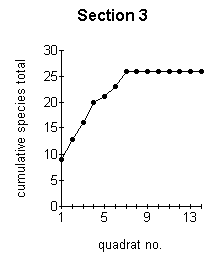ECOLOGICAL SAMPLING METHODS cont'd
Contents
Many ecological surveys are carried out over extended periods of time, with sampling taking place at regular intervals within a particular habitat. In such cases, it is necessary to estimate the number of samples which should be taken at each sampling period. The minimum number of samples which should be taken to be truly representative of a particular habitat, can be ascertained by graphing the number of species recorded, as a function of the number of samples examined.
 |
The graph (left) is an example of this, obtained from a survey of a heathland area. The first sample yielded 9 different species. With the second sample, a total of 13 species had been found. After 5 samples had been examined, the total species number had risen to 21. By the time 7 samples had been taken, no more new species were being found. At this point, further sampling is becoming unnecessary. This graph therefore shows us that for this particular habitat, we need to sample at least 7 samples in each sampling period. Further sampling will merely waste time and duplicate results. |
Systematic sampling is when samples are taken at fixed intervals, usually along a line. This normally involves doing transects, where a sampling line is set up across areas where there are clear environmental gradients. For example you might use a transect to show the changes of plant species as you moved from grassland into woodland, or to investigate the effect on species composition of a pollutant radiating out from a particular source .
A transect line can be made using a nylon rope marked and numbered at 0.5m, or 1m intervals, all the way along its length. This is laid across the area you wish to study. The position of the transect line is very important and it depends on the direction of the environmental gradient you wish to study. It should be thought about carefully before it is placed. You may otherwise end up without clear results because the line has been wrongly placed. For example, if the source of the pollutant was wrongly identified in the example given above, it is likely that the transect line would be laid in the wrong area and the results would be very confusing. Time is usually money, so it is worth while thinking about it before starting.
A line transect is carried out by unrolling the transect line along the gradient
identified. The species touching the line may be recorded along the whole length of the
line (continuous sampling). Alternatively, the presence, or absence of species at each
marked point is recorded (systematic sampling). If the slope along the transect line is
measured as well, the results can then be inserted onto this profile.
| More information on line transects |